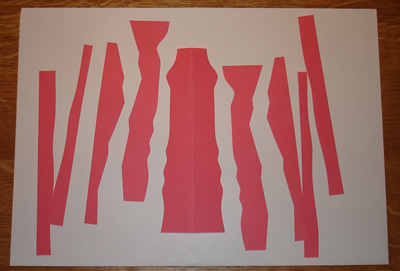Skip over navigation
For this activity, you'll need:
Keep the square folded and hold it so that the fold is on the left or the right. Then cut from top to bottom of the folded square, near the open edges, like this:

You could cut in a straight line, in a 'zig-zag' line or in a wavy line, it is completely up to you. You should now have two strips of paper and the rest of the folded square.
Repeat this a few times so that each time, you cut off two pieces of paper from the open edge of the rest of the folded square.
You should be left with lots of strips and the folded edge, which you can open out:

Mark out the centre of the backing paper.
Next, stick the piece which was the folded edge of the square onto the backing sheet so that the centre of the backing sheet is exactly underneath the fold.
Can you lay out the strips of paper on either side of the folded piece so that they form mirror images of each other, with the fold being the mirror line?
You could create more exploded squares. For example, what happens if you ...
I am sure you can think of your own 'what if ...?' questions.
Please do send us photos of your exploded squares. We'd love to see them.

Or search by topic
Number and algebra
Geometry and measure
Probability and statistics
Working mathematically
Advanced mathematics
For younger learners
Exploded Squares
Age 5 to 7
Challenge Level 





For this activity, you'll need:
- A square piece of paper (you could use a gummed square or plain paper or wrapping paper ...)
- A piece of plain backing paper, larger than the square of paper
- Scissors
Keep the square folded and hold it so that the fold is on the left or the right. Then cut from top to bottom of the folded square, near the open edges, like this:

You could cut in a straight line, in a 'zig-zag' line or in a wavy line, it is completely up to you. You should now have two strips of paper and the rest of the folded square.
Repeat this a few times so that each time, you cut off two pieces of paper from the open edge of the rest of the folded square.
You should be left with lots of strips and the folded edge, which you can open out:

Mark out the centre of the backing paper.
Next, stick the piece which was the folded edge of the square onto the backing sheet so that the centre of the backing sheet is exactly underneath the fold.
Can you lay out the strips of paper on either side of the folded piece so that they form mirror images of each other, with the fold being the mirror line?
You could create more exploded squares. For example, what happens if you ...
- fold the square of paper in half in a different way?
- have the mirror line in a different orientation (e.g. horizontal, vertical ...)?
- fold two (or more) squares together so that you cut them in exactly the same way but arrange them differently on the backing paper?
- fold in half again before cutting?
I am sure you can think of your own 'what if ...?' questions.
Please do send us photos of your exploded squares. We'd love to see them.
This activity is based on an idea in Mathematics Through Art and Design published by Collins Educational.
You may also like
Let's Investigate Triangles
Vincent and Tara are making triangles with the class construction set. They have a pile of strips of different lengths. How many different triangles can they make?

